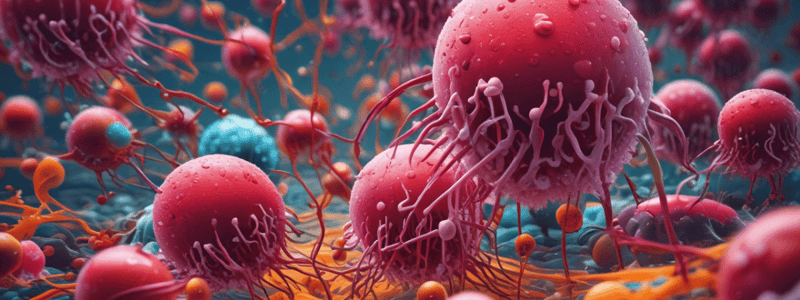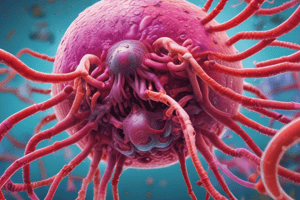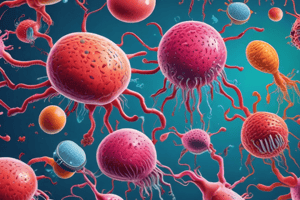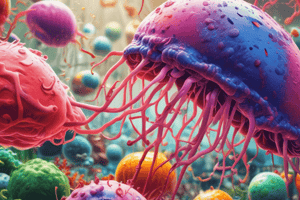Podcast
Questions and Answers
Which of the following is the primary mode of transmission for foodborne and waterborne diseases?
Which of the following is the primary mode of transmission for foodborne and waterborne diseases?
- Airborne transmission
- Contaminated food and water (correct)
- Vector-borne transmission
- Direct contact with infected individuals
Which of the following best describes the difference between a bacterial infection and a bacterial intoxication in the context of foodborne and waterborne diseases?
Which of the following best describes the difference between a bacterial infection and a bacterial intoxication in the context of foodborne and waterborne diseases?
- Bacterial infections typically result in more severe gastrointestinal symptoms, while bacterial intoxications usually cause milder symptoms.
- Bacterial infections have a shorter incubation period and faster onset of symptoms, while bacterial intoxications have a longer incubation period and slower onset of symptoms.
- Bacterial infections involve the consumption of pathogens, while bacterial intoxications involve the consumption of toxins produced by pathogens. (correct)
- Bacterial infections are more common in developed countries, while bacterial intoxications are more prevalent in developing countries.
Which of the following is the most important factor in the prevention of foodborne and waterborne diseases?
Which of the following is the most important factor in the prevention of foodborne and waterborne diseases?
- Regular sanitization of food preparation surfaces
- Washing hands (correct)
- Adequate cooking of food
- Proper food storage
Which of the following is the primary reservoir for pathogens that cause foodborne and waterborne diseases?
Which of the following is the primary reservoir for pathogens that cause foodborne and waterborne diseases?
Which of the following best describes the typical symptoms associated with foodborne and waterborne diseases?
Which of the following best describes the typical symptoms associated with foodborne and waterborne diseases?
Which of the following is a key virulence factor of the bacteria that causes cholera?
Which of the following is a key virulence factor of the bacteria that causes cholera?
What is the primary mode of transmission for the virus that causes hepatitis A?
What is the primary mode of transmission for the virus that causes hepatitis A?
Which of the following is a key prevention strategy for brucellosis, a zoonotic disease?
Which of the following is a key prevention strategy for brucellosis, a zoonotic disease?
What is the primary reservoir for the virus that causes hepatitis A?
What is the primary reservoir for the virus that causes hepatitis A?
Which of the following is a key difference between the transmission of rotavirus and norovirus, two common causes of viral gastroenteritis?
Which of the following is a key difference between the transmission of rotavirus and norovirus, two common causes of viral gastroenteritis?
What is the primary reservoir for Clostridium difficile?
What is the primary reservoir for Clostridium difficile?
Which of the following is a key factor in the development of Clostridium difficile-associated diarrhea (CDAD)?
Which of the following is a key factor in the development of Clostridium difficile-associated diarrhea (CDAD)?
Which of the following is the most effective treatment for Clostridium difficile-associated diarrhea?
Which of the following is the most effective treatment for Clostridium difficile-associated diarrhea?
What is the primary mode of transmission for Clostridium difficile?
What is the primary mode of transmission for Clostridium difficile?
What is the most common symptom of Clostridium difficile-associated diarrhea?
What is the most common symptom of Clostridium difficile-associated diarrhea?
What is a common method for the prevention of Typhoid Fever?
What is a common method for the prevention of Typhoid Fever?
Which bacterial genus causes Bloody Dysentery?
Which bacterial genus causes Bloody Dysentery?
What is the most virulent species among the four species of Shigella?
What is the most virulent species among the four species of Shigella?
Which toxin causes severe damage to the intestinal mucosal lining in Bacillary Dysentery?
Which toxin causes severe damage to the intestinal mucosal lining in Bacillary Dysentery?
What is the significance of being a chronic carrier in Salmonellosis?
What is the significance of being a chronic carrier in Salmonellosis?
What is the main mode of transmission for Hemorrhagic Colitis caused by ground beef?
What is the main mode of transmission for Hemorrhagic Colitis caused by ground beef?
Which of the following statements about Shigella is true?
Which of the following statements about Shigella is true?
What distinguishes Vibrio cholerae as the causative agent of Cholera?
What distinguishes Vibrio cholerae as the causative agent of Cholera?
In Cholera, the virulence factor produced by Vibrio cholerae leads to what physiological effect?
In Cholera, the virulence factor produced by Vibrio cholerae leads to what physiological effect?
What distinguishes Hemolytic Uremic Syndrome (HUS) as a complication of Hemorrhagic Colitis?
What distinguishes Hemolytic Uremic Syndrome (HUS) as a complication of Hemorrhagic Colitis?
Which of the following statements about Shigella dysenteriae is correct?
Which of the following statements about Shigella dysenteriae is correct?
Which of the following statements about bacterial gastroenteritis caused by Enterotoxigenic E. coli (ETEC) is incorrect?
Which of the following statements about bacterial gastroenteritis caused by Enterotoxigenic E. coli (ETEC) is incorrect?
Which of the following statements about the transmission of waterborne and foodborne diseases is correct?
Which of the following statements about the transmission of waterborne and foodborne diseases is correct?
Which of the following statements about the characteristics of Enterotoxigenic E. coli (ETEC) is correct?
Which of the following statements about the characteristics of Enterotoxigenic E. coli (ETEC) is correct?
Which of the following diagnostic methods is commonly used for identifying Shigella dysenteriae infections?
Which of the following diagnostic methods is commonly used for identifying Shigella dysenteriae infections?
Which of the following statements accurately describes the pathogenesis of Salmonella enterica serovar Typhimurium?
Which of the following statements accurately describes the pathogenesis of Salmonella enterica serovar Typhimurium?
Which of the following is NOT a common reservoir or source of Salmonella enterica serovar Typhimurium?
Which of the following is NOT a common reservoir or source of Salmonella enterica serovar Typhimurium?
What is the primary mode of transmission for Salmonella enterica serovar Typhimurium?
What is the primary mode of transmission for Salmonella enterica serovar Typhimurium?
Which of the following statements accurately describes the incubation period and symptoms of Salmonella gastroenteritis (salmonellosis)?
Which of the following statements accurately describes the incubation period and symptoms of Salmonella gastroenteritis (salmonellosis)?
Which of the following statements accurately describes the reservoir and mode of transmission for Salmonella enterica serovar Typhi, the causative agent of typhoid fever?
Which of the following statements accurately describes the reservoir and mode of transmission for Salmonella enterica serovar Typhi, the causative agent of typhoid fever?
Which of the following statements accurately describes the clinical manifestations of typhoid fever?
Which of the following statements accurately describes the clinical manifestations of typhoid fever?
Which of the following diagnostic methods is typically used to confirm a case of typhoid fever?
Which of the following diagnostic methods is typically used to confirm a case of typhoid fever?
Which of the following statements accurately describes the concept of chronic carriers in the context of Salmonella infections?
Which of the following statements accurately describes the concept of chronic carriers in the context of Salmonella infections?
Which of the following best describes the primary prevention strategy for foodborne and waterborne diseases caused by Salmonella?
Which of the following best describes the primary prevention strategy for foodborne and waterborne diseases caused by Salmonella?
Which of the following statements accurately describes the treatment approach for Salmonella gastroenteritis (salmonellosis)?
Which of the following statements accurately describes the treatment approach for Salmonella gastroenteritis (salmonellosis)?
Flashcards are hidden until you start studying




